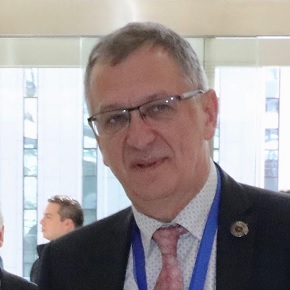 |
||
|
The second stage of the lead universal nuclear icebreaker Arktika sea trials is completed Press Service of FSUE Atomflot, PUBLISHED 18.09.2020 On September 17, after completion of the second stage of sea trials, the lead universal nuclear icebreaker "Arktika" ('Arctic') of the project 22220 returned to St. Petersburg. From June 23 to September 16 an inspection of mechanisms and equipment of the nuclear-powered vessel was carried out in the Gulf of Finland and Baltic Sea. Experts tested the electric power system under running conditions and maneuverable characteristics of the vessel under different draft variants. "The program of sea trials has been fully implemented," says Mustafa Kashka, Director General of FSUE Atomflot. The shipbuilders, contractors and the delivery crew have done a great deal of work. We are satisfied with the results. The Arktika nuclear icebreaker is ready to sail to Murmansk." On September 22, Arktika, the lead universal nuclear-powered icebreaker, will depart from the completion embankment of the Baltic Shipyard towards the Murmansk sea port. The passage is planned to take about two weeks. During this time, the nuclear icebreaker will be tested in ice conditions. The lead universal nuclear icebreaker of project 22220 is being built by the OJSC Baltic Shipyard on commission of Rosatom State Atomiс Energy Corporation. The keel for the icebreaker was laid on November 5, 2013 and the launch of the vessel took place on June 16, 2016. It will be the largest and most powerful nuclear icebreaker in the world. The icebreaker is designed for independent pilotage of ships, including large-capacity ones, and for leading the fleet in the Western Arctic region. The vessel's dual-draft concept allows for operating it both in the Arctic and in the mouths of the polar rivers, in particular in shallower areas of the Yenisei estuary and the Ob Bay area. Main characteristics of the vessel: length: 173,3 meters (160 m, dwl); width: 34 meters (33 m, dwl); height - 15.2 meters; power capacity: 60 mw (on propeller shafts); cruising speed: 22 knots (in clear water); draft - 10.5 meters/8.65 meters; maximum ice penetration - 2.9 meters; displacement - 33 540 tons; estimated service life - 40 years; number of crew - 53 people. "Iceberg" Central Design Bureau designed the technical project of the icebreaker in 2009. The icebreaker is equipped with specially designed two new generation RITM-200 reactors and a steam turbine unit with an overall power capacity of 175 MW. RITM-200 is an innovative and unique design developed by of one of the oldest design bureaus of the nuclear industry - OKBM Afrikantov (Nizhny Novgorod, part of JSC Atomenergomash). The rich experience of the construction and operation of reactors for nuclear icebreakers as well as modern trends of the world nuclear power engineering were the basis for the design of RITM-200. It includes two reactors with the of 175 megawatts each. RITM-200 is almost twice as light and compact as previous reactors, therefore it is cheaper in terms of material intensity and takes less space on the vessel and thus more economically efficient. Such a solution is structurally achieved due to the fact that steam generators, which were previously located outside the reactor, are now located directly in it, which is called an integrated layout. The nuclear-powered ship was named after the legendary icebreaker "Arktika", which became the first ship in history to reach the North Pole in the above-water position. Topics: Nuclear ships, Russia Other news: WANO appoints Robert Gambrill as Director of WANO Atlanta Centre He has formally replaced Russ Brian. The complete MOX-core is planned in 2022. WANO, IAEA, EPRI collaborate to help new nuclear power units to start up safely and on time The white paper is available here (bottom left section to download). |
Hero of the day 
Vladimir Kriventsev: FR21 provides excellent opportunities The International Atomic Energy Agency brings together the fast reactor and related fuel cycle community and countries and the wider public interested in these technologies by organising the International Conference on Fast Reactors and Related Fuel Cycles: Sustainable Clean Energy for the Future or FR21. INTERVIEW
William D. Magwood, IV OPINION
Vyacheslav Kupriyanov, |

